Position 50 to 20 in 24 Hours Without Building Links
The Challenge
When competing against established brands with years of content and thousands of backlinks, new websites face an uphill battle to gain visibility. This was precisely our situation when targeting the keyword "SEO report builder."
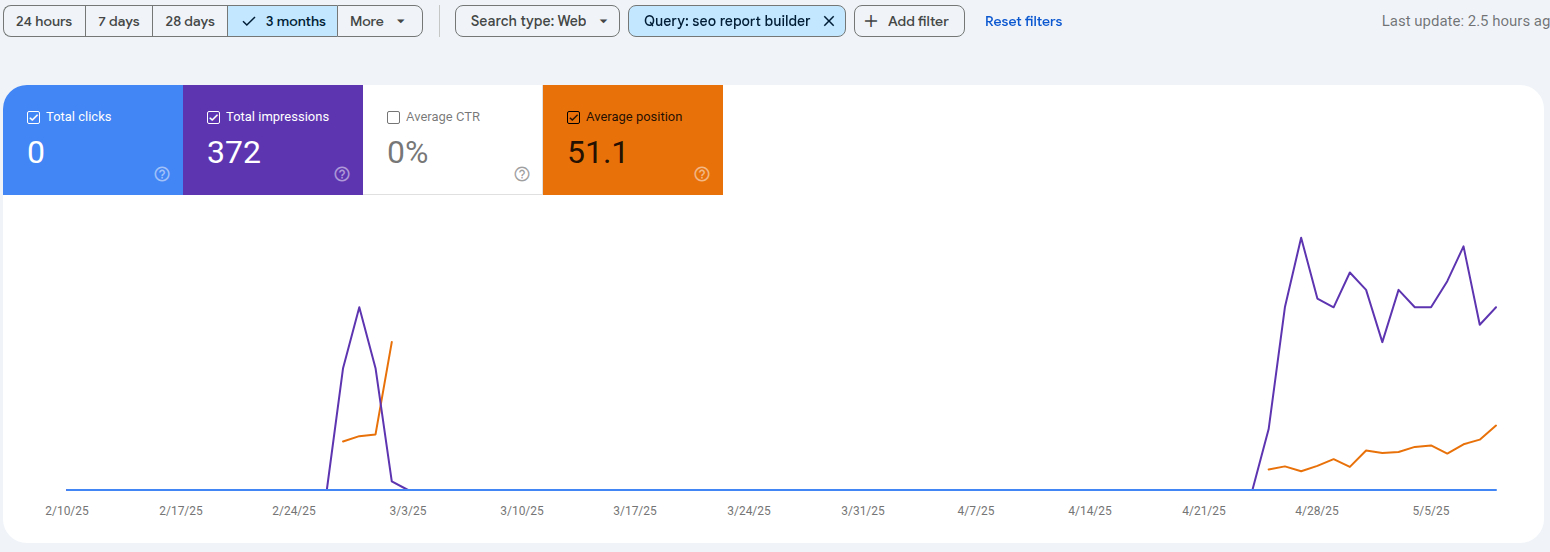
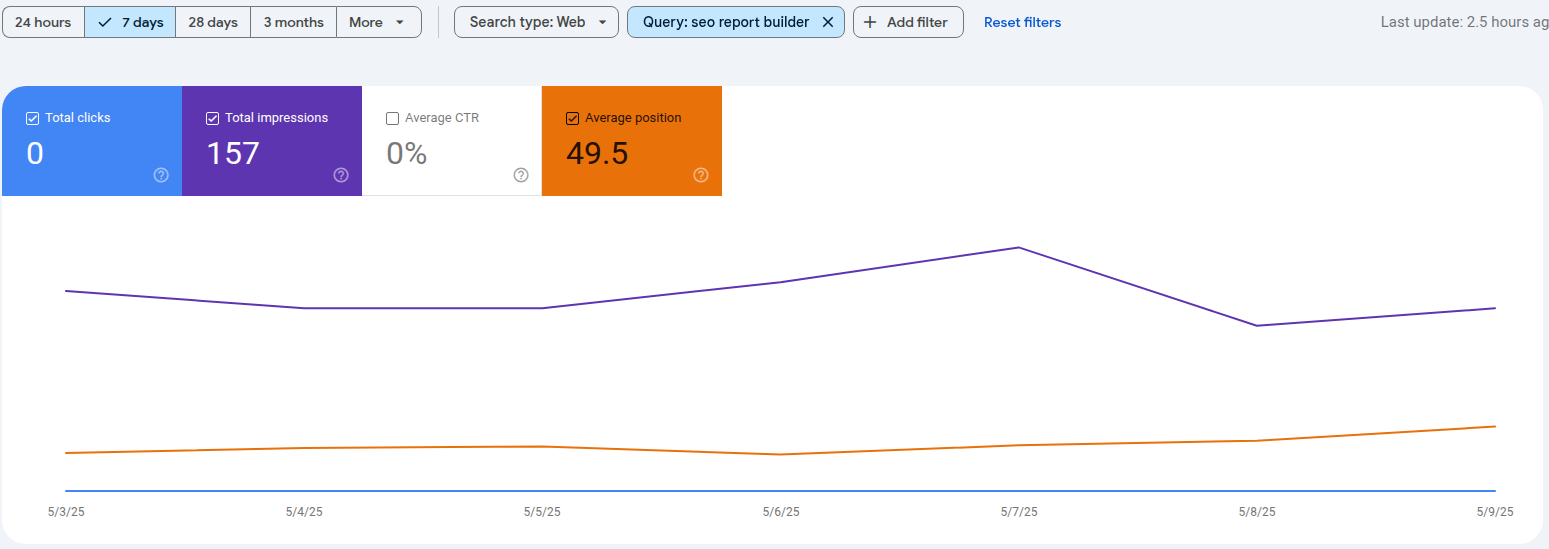
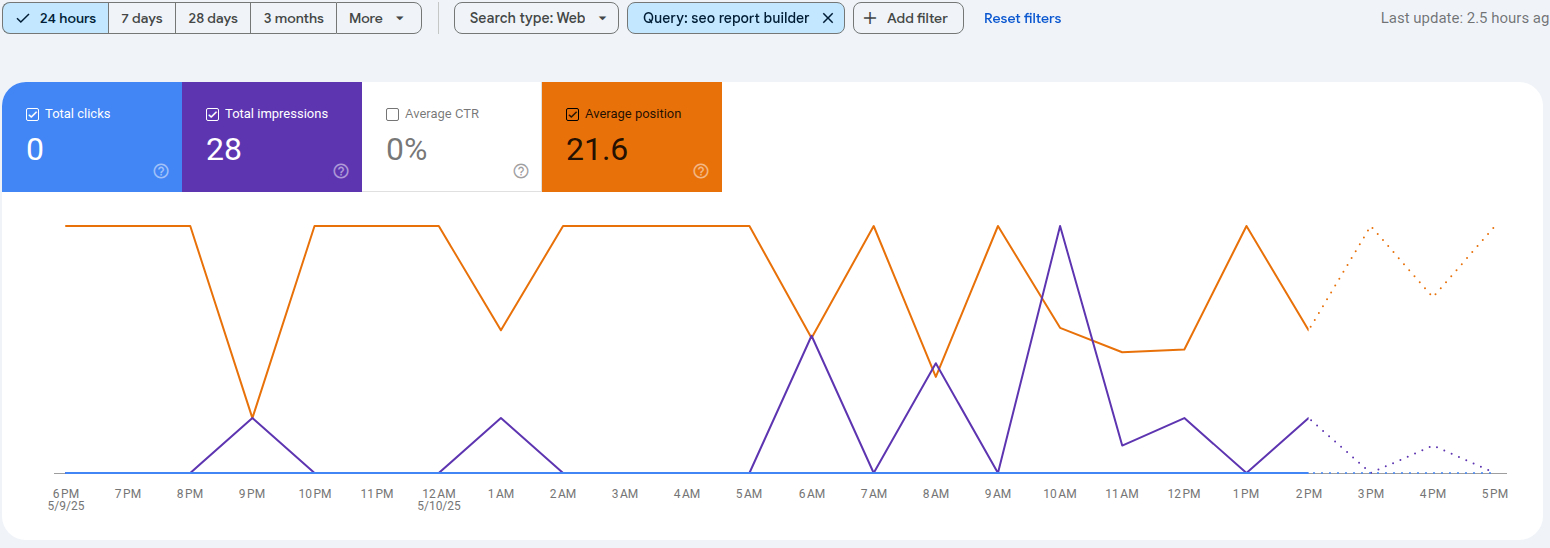
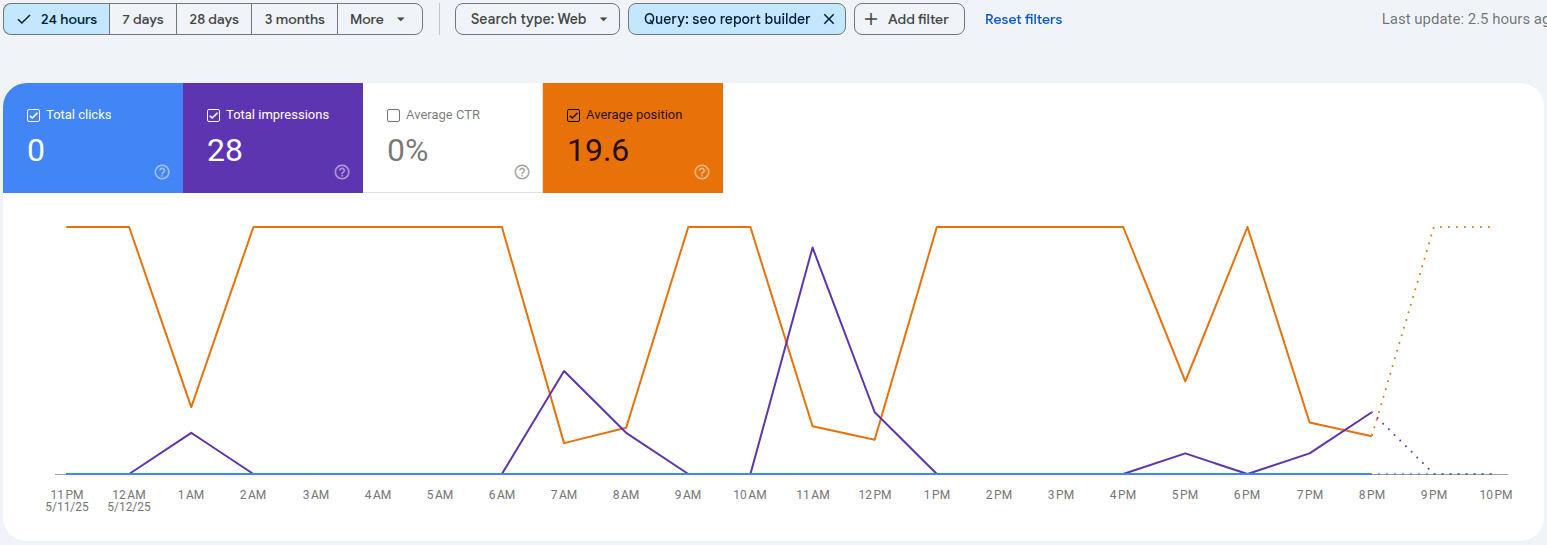
For nearly three months, our page hovered around position 50 in Google search results. Despite creating what we considered quality content, we failed to break through to page 1 or 2 where meaningful traffic begins.
Our competitors included industry giants with:
- Domain authorities 40-45x higher than ours
- Content libraries spanning hundreds of optimized pages
- Robust backlink profiles built over many years
The competitive landscape: Our DA-2 site (Ahrefs, grain of salt on DA values, but great for comparison) was targeting a KD-50 keyword against established SEO tool giants with DA 80-90+ domain authority - representing a 40-45x authority disadvantage in one of the most competitive niches online.
With minimal existing backlinks and a relatively new domain, we needed a strategy that didn't rely on building authority through traditional link building campaigns.
Our Approach: Data Over Assumptions
Rather than following generic SEO advice, we took a completely different approach.
We followed the blueprint from the SEOLinkMap Competitor Research tool to analyze exactly what was working for the top-ranking pages for this specific keyword and which SEO factors we could reliably ignore.
The tool measured dozens of on-page factors across the top-ranking results to identify:
- Which measurable elements successful pages had in common
- The optimal ranges for key content metrics
- Which commonly recommended "SEO factors" showed no correlation with rankings
For our "SEO report builder" keyword, the analysis revealed some surprising specifics: while Lighthouse Performance scores showed no correlation with rankings, Cumulative Layout Shift (CLS) emerged as a "possible must-have requirement." Despite both being technical performance metrics, the tool identified CLS as critical - every top result except one outlier clustered tightly between 0 and 0.05 - while Lighthouse scores could be safely ignored.
Similarly, while word count wasn't strongly tied to ranking position, readability (Flesch-Kincaid ease) proved essential - nothing that was hard to read had made it into the top SERPs. All successful pages maintained simple, accessible content.
The tool didn't just present this data - it interpreted these patterns and told us exactly where to focus our optimization efforts and what we could safely ignore.
The Competitor Research Report evaluates every factor using three key scores:
- Correlation: Does this factor actually affect rankings? (Many "best practices" show no real correlation)
- Confidence: How certain are we this pattern is real versus random chance?
- Influence: When you change this factor, how much does it impact your ranking?
These three scores work together to prioritize which optimizations matter most and which popular SEO advice to ignore for this specific keyword.
Instead of guessing what Google might want, we let the Competitor Research tell us precisely what was already working in this specific SERP.
Implementation Strategy
Based on the Reports analysis, we completely rebuilt our page targeting "SEO report builder" to align with the patterns identified in top-performing content.
Key implementation elements included:
Content Structure:
- Maintained a specific measurement range suggested by the Competitor Research Report from SEOLinkMap.com
- Kept paragraphs shorter than the measured threshold suggested by the Report
- Implemented a comprehensive jumplink navigation system (identified as a common feature of top pages)
Content Depth:
- Developed thorough coverage of the topic based on measured optimal content parameters and gap analysis
- Balanced content depth with appropriate readability scores and other metrics as suggested by the Competitor Research report
- Structured information in a pattern consistent with top-ranking pages
All optimizations were based directly on the Competitor Research Report for the target keyword. The Report was compiled with measurable data points from successful pages rather than SEO assumptions or generic best practices.
The Results: Immediate and Significant
Within just 24 hours of publishing the optimized page, we saw dramatic improvements that continued to improve:
| Metric | Before | After (24 hours) | After (72 hours) | Total Improvement |
|---|---|---|---|---|
| Ranking Position | ~50 | 21 | 19 | +31 positions |
| Keywords Ranking | 14 | 30 | 38 | +171% |
| Page Visibility | Limited | Significantly expanded | Top 20 (Page 2) | - |
Most impressively, these improvements occurred:
- Without building a single new backlink
- Despite competing against established domain authorities in the SEO keyword space
- In a highly competitive SEO tools niche
Some of the newly ranking terms have search volume approaching my target keyword, opening opportunities for further optimization and traffic growth.
ROI Analysis
This data-driven optimization approach as suggested by the Report delivered exceptional ROI:
- Investment: $30 for the research report + approximately 3 days of content development
- Return: 30-position ranking improvement and 171% increase in keyword visibility
- Time-to-result: Just 24 hours from publication to measurable results, continued improvements beyond 24 hours
The cost efficiency becomes even more apparent when comparing link building requirements:
- Page 5-6 to Top Results: Typically requires 50-100+ high-quality backlinks1, costing $5,000-$150,000+2 and taking 6-12 months
- Page 2 to Top Results: Usually needs 10-25 quality backlinks3, costing $1,000-$37,5002 over 3-6 months
By achieving page 2 rankings through content optimization as defined within the Report alone, we've potentially saved $4,000-$112,500 in link building costs while positioning ourselves for a much more achievable final push to top rankings.
This strategy proved remarkably efficient compared to traditional link building campaigns that often take months to deliver similar results at significantly higher costs.
By optimizing content based on the Report's findings, we effectively "cut the line" - jumping ahead of the typical slow progression toward top rankings and removing major obstacles.
Specifically, we eliminated the need for expensive link building to climb 30 positions, positioning ourselves for a more achievable final push to page 1.
Key Takeaways
This case study demonstrates several important lessons:
- SERP-specific optimization works: Generic SEO best practices can't match the effectiveness of strategies based on direct measurement of what's working for a specific keyword. The measurable "intent" of searchers.
The objective measurements and determinations found in the Report lay out exactly what the current top performers are doing (what works and what doesn't) for specific SERPs.
- On-page factors can overcome authority gaps: Even with no meaningful backlinks, properly optimized content can significantly outperform expectations in competitive niches.
- Measurable patterns reveal Google's preferences: By analyzing what's already working, we can identify the specific content patterns Google favors for particular search queries.
- Implementation delivered rapid results: By aligning our content precisely with what the Report identified as already working in this SERP, we saw significant ranking improvements within just 24 hours. The speed of these results exceeded our expectations.
- Additional backlinks would likely help: Despite the gains without having used links, it is understood that additional backlinks would help close the gap from high teens to top 3 position and to secure the gains longer term.
It is expected this will require fewer resources for backlinks to get top position from the current 19th position than it would have from the previous ~50th place positioning, before the findings in the Report were applied.
- Content optimization creates a ripple effect of savings: By achieving page 2 rankings through data-driven content alone, we've not only improved immediate visibility but dramatically reduced future link building requirements.
This compounds the ROI - saving thousands in link building costs while positioning a webpage for more achievable and cost-effective final optimization efforts.
- Following the Report's blueprint was crucial: Success came from following the Report's SERP-specific recommendations rather than applying general SEO best practices that may work elsewhere but not for this particular keyword.
Regardless of your SEO philosophy, this approach delivers value:
- Believe in holistic SEO? The Report shows which factors actually matter for each SERP
- Focus purely on content? Get the exact blueprint for ranking as well as possible without links
- Convinced links are everything? Save thousands by skipping 30+ positions of link building
Next Steps
Based on this success, we're now using SEOLinkMap's Competitor Research Reports for additional keywords to expand our visibility in related search queries.
The ability to identify exactly what matters for specific keywords by using the Competitor Research Report provides a competitive advantage that's particularly valuable for competing against established authorities.
Update
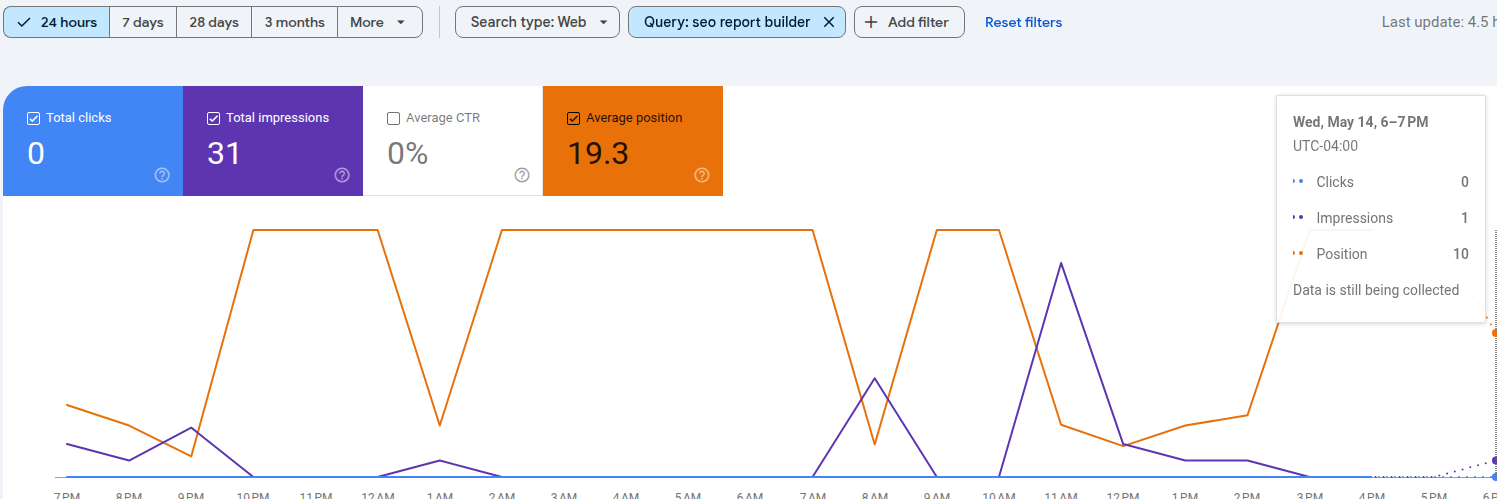
1 HigherVisibility (2024): https://www.highervisibility.com/seo/learn/how-many-backlinks-to-rank/
2 Editorial.link (2025): https://editorial.link/link-building-pricing/
3 Search Logistics (2022): https://www.searchlogistics.com/learn/seo/link-building/how-many-backlinks/